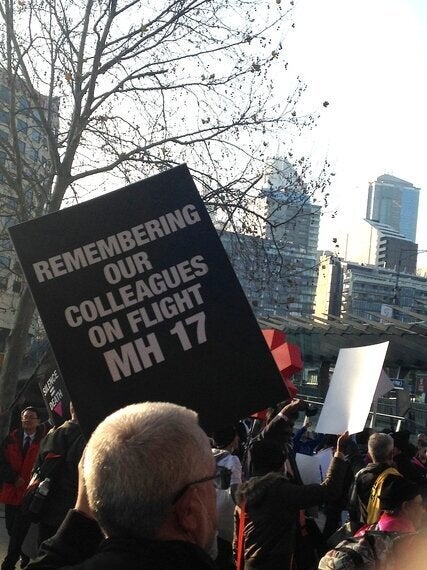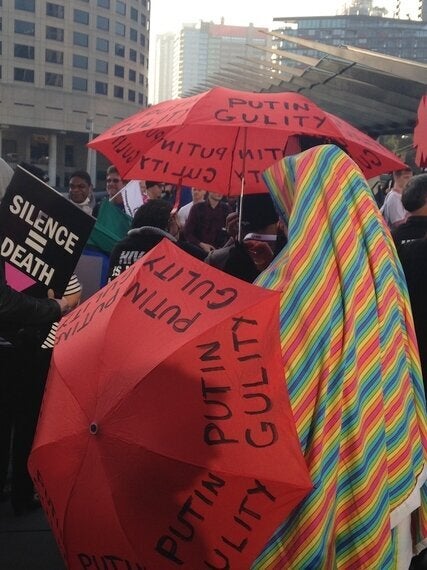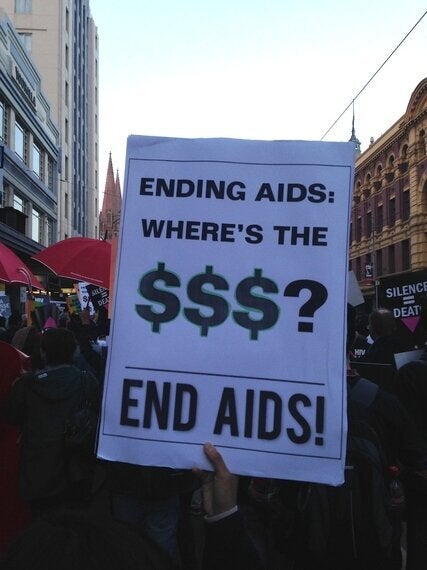Last week, the 20th International AIDS Conference took place in Melbourne, Australia. The rhetoric throughout was one of ambition: the conference theme was "stepping up the pace", a Melbourne Declaration called for "no-one left behind", and there was constant talk of ending AIDS by 2030. But, while such ambition is to be applauded, it does not tally with the current situation on the ground for people who use drugs.
The conference itself brought together more than 13,000 people from the global community of HIV advocates, doctors, academics, community representatives, activists and the media. It began in a somber mood - as delegates mourned the loss of colleagues and friends on board the ill-fated Malaysian Airlines flight shot down over Ukraine a few days before - but proceeded in their honour and remembrance.

Michel Sidibe, Executive Director of UNAIDS, opened the five day event by articulating his vision for an end to AIDS - and quoted Nelson Mandela: "After climbing a great hill, we find that there are many more hills to climb". He referred to the 2030 vision as the "final climb" and called on everyone working to end the epidemic to act "with the same sense of urgency" to reach this difficult summit. He also set a new HIV treatment target for 2020: "90% of people tested, 90% of people living with HIV on treatment, and 90% of people on treatment with suppressed viral loads".
Cue a new slogan: "90-90-90". In terms of the science, this is achievable. The HIV response has made incredible advances, and nearly 14 million people now have access to treatment that can render the virus undetectable. HIV is no longer the death sentence it once was.
But HIV has never been about science alone - so what about the politics? Last week's conference highlighted many stark and sobering warnings. HIV and AIDS cannot be beaten without addressing the realities faced by the most disadvantaged and stigmatised groups. These key populations - men who have sex with men, people who inject drugs, prisoners, sex workers and transgender people - have always borne a disproportionate burden in this epidemic. It is for them that the critical nexus of economic and social marginalisation, unjust laws, HIV risk and political ignorance is most pronounced.

Accordingly, there were a number of strong calls at the conference for drug law reform and the decriminalisation of people who use drugs:
•New reports and guidance from the World Health Organisation and UNAIDS explicitly called for drug law reforms to remove barriers to the HIV response for people who use drugs.
•The former Australian high court judge Michael Kirby presented the groundbreaking report from the Global Commission on HIV and the Law, which states that "Countries must reform their approach towards drug use. Rather than punishing people who use drugs who do no harm to others, they must offer them access to effective HIV and health services, including harm reduction and voluntary, evidence-based treatment for drug dependence".
•The Global Commission on Drug Policy held a high-level panel, which included Sir Richard Branson and Michel Kazatchkine, the UN Envoy for HIV in Eastern Europe and Central Asia. Their message was unequivocal: governments have a moral imperative to stop punishing and criminalising people for using drugs.
At the same time, however, we heard about a looming global crisis in funding for services for people who use drugs - such as needle and syringe distribution and opiate substitution treatment. While UNAIDS estimates that at least $2.3 billion is needed to provide these essential HIV prevention measures, it seems that just 7% of this amount is actually being spent, just 8% of people who inject drugs have access to opioid substitution therapy, and just 4% received anti-retroviral treatment. The majority of these people live in middle income countries, but donors - including the Global Fund to Fight AIDS, Tuberculosis and Malaria - are slowly turning their backs on these countries. Their expectation is that middle income governments will meet the costs of their own HIV responses - but we know that many governments have historically failed to adequately invest in services for marginalised populations. Yet we also know that these same governments spend vast sums on drug law enforcement - an estimated $100 billion is squandered each year on ineffective, abusive and repressive drug policies control measures. Just a fraction of this money - 10 percent by 2020 - would cover the global funding gap for proven, effective HIV and hepatitis services.

Huge challenges remain if we are to end AIDS. Last year alone, more than 2 million people were newly infected with HIV, and there were 1.5 million AIDS-related deaths. People who inject drugs are 22 times more likely to have HIV than the general population as a result of punitive drug laws, stigma and discrimination. Crucial efforts to advocate for people who inject drugs and to protect their human rights - referred to as "critical enablers" by the UN - account for less than 1% of all HIV spending. Without addressing structural legal and policy barriers there will never be an end to AIDS and, as we embark on the next stage of this journey - towards the 90-90-90 target - people who inject drugs will be left behind.
There were, of course, plenty of positive stories showcased at the AIDS conference too: a project in Kenya where police champions are working with people who use drugs and sex workers to stop police abuse and educate their law enforcement peers about harm reduction; PKNI - the Indonesian network of people who use drugs - deservedly winning the Red Ribbon Award, and being commended by the Indonesian Health Minister for their activism. However, these important activities fall into the category of the fore-mentioned "critical enablers" and are at risk in the current funding environment.
So, for me, the take home messages from Melbourne are that the science is crucial but it will not be enough by itself, and that the ambitious new targets for the HIV movement are just empty rhetoric unless more is done for key populations. Despite all the climbing that we have done over the last 30 years, we are still at the foot of a huge mountain - the urgent need to reform bad drug laws and policies that undermine the HIV response. Turning this around requires greater international leadership, political commitment and will, tireless health and human rights advocacy, and a scale-up (rather than down) in donor support for the countries most in need. Only then can we begin to seriously talk about a world without AIDS.